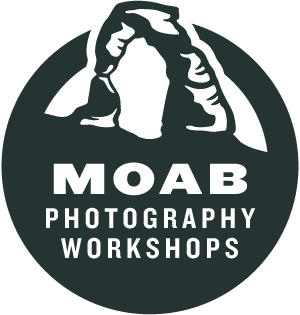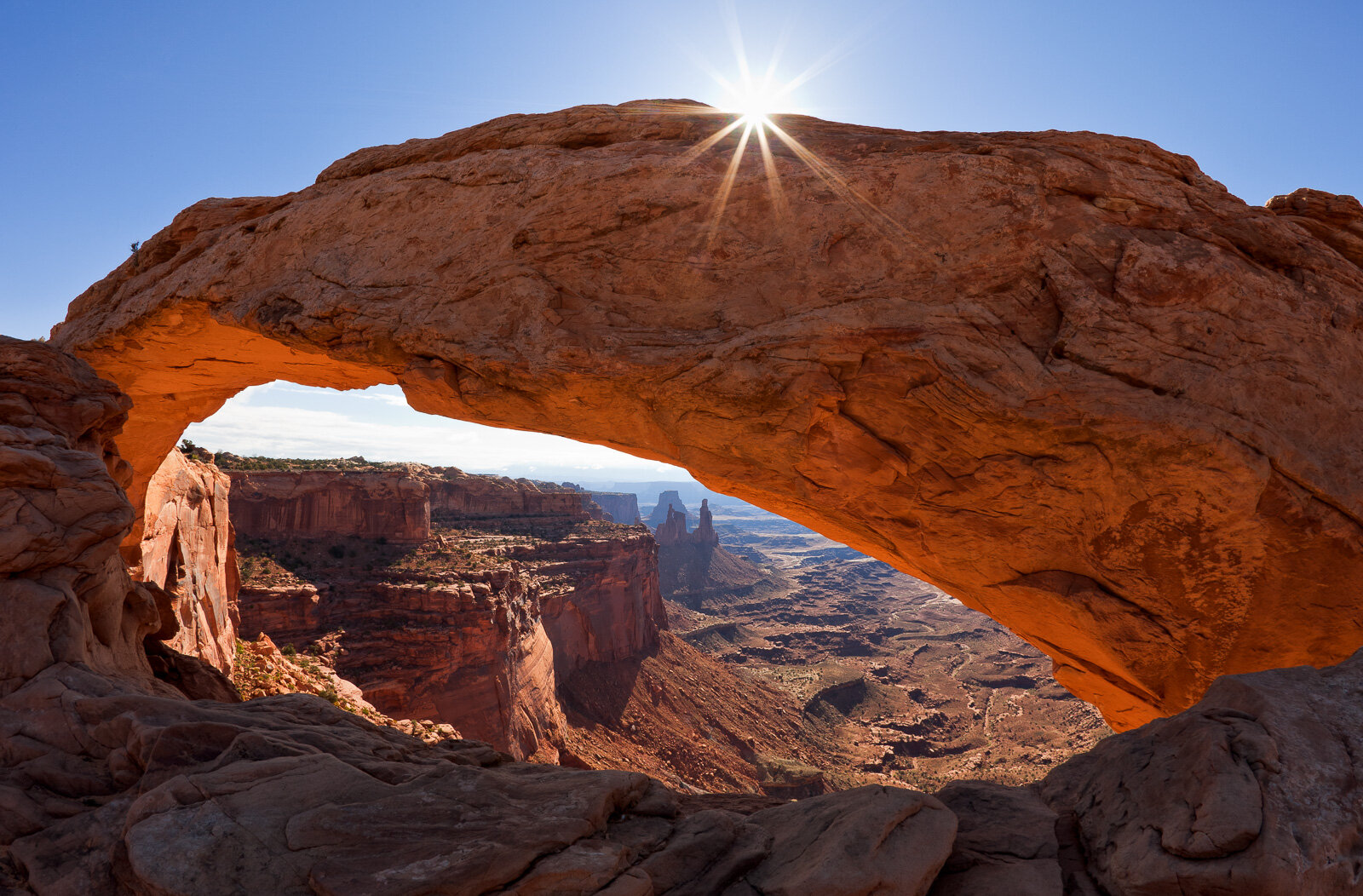This post brought to you by eFotoGuide, the ultimate guides to photographing America’s national parks. Check out our ebook guides to Arches, Big Bend and Zion National Parks. Each ebook contains information for over 20 of the most stunning locations in each park, plus everything you’ll need to plan a successful trip. At only $15 each, or $40 for the whole bundle, it’s quite the bargain!
Mesa Arch needs no introduction. If you’re a landscape photographer, even if you picked up a camera for the first time yesterday, you know of Mesa Arch. You’ve seen photos of Mesa Arch. You’ve heard stories about Mesa Arch. Like Antelope Canyon, Snake River Overlook, the Dallas Divide or Mount Rainier’s Reflection Lakes, Mesa Arch has achieved the much heralded rank of “icon”.
That said, I was always surprised how many questions I’d get about photographing this spectacular location during private photography workshops. What lens should I use? Where’s the best composition? What time of day is ideal? When should we plan to arrive? In this post I’ll attempt to answer all of those questions and more, arming you with all the knowledge necessary to produce your own dynamic images of Mesa Arch.
The Basics
Best Time of Day: Sunrise to early morning
Best Season: Spring, Summer, Fall and Winter
Hike Stats: .7 miles R/T, 75’ elevation gain
Travel Time from Moab: 45 minutes
Solitude: None, Zero, Zip
Why Should I Photograph Mesa Arch?
Expansive views of Buck Canyon, Airport Tower, Washer Woman Arch, Monster Tower and the La Sal Mountains are framed through Mesa Arch, which sits at the very edge of a high cliff with dizzying exposure below. Sunrise and early morning light strikes the red sandstone cliff below and reflects onto the underside of the arch, creating a supernatural glow that quite literally takes your breath away. Or maybe it’s the exposure. Either way, it’s a visual treat for you and your camera.
How Do I Get to Mesa Arch?
Mesa Arch is located in the Island in the Sky district of Canyonlands National Park, approximately 45 minutes from downtown Moab. From town, drive north on Highway 191 for approximately 9 miles. Turn left, or west, on Highway 313. Follow Highway 313 to the intersection with Grand View Point Road and continue straight toward Canyonlands. (Highway 313 turns left and dead ends at Dead Horse Point State Park) From the Canyonlands entrance booth, continue straight for approximately 6.3 miles to the signed Mesa Arch trailhead on your left.
From the parking lot, a well marked obvious trail proceeds up a small hill before dropping down to Mesa Arch. The trail is easy to follow but can be slippery as it large sandstone slabs are often covered with blown sand.
Sunrise light filters through wildfire smoke filling Buck Canyon as Washer Woman Arch, Monster Tower and Airport Tower rise high above the White Rim in Canyonlands National Park near Moab, Utah
What Camera Equipment Should I Bring to Mesa Arch?
Bring. It. All. Seriously. I’ve used everything from a 15mm fisheye lens to a 100-400mm telephoto at Mesa Arch. Most importantly, bring a tripod and a 5 gallon bucket of patience. Make that two. This is one of the most popular photography locations in all of Moab-landia and the area in which the classic compositions are made is very small. You’ll need to arrive early to secure a tripod spot for sunrise. At a minimum, get there one hour before sunrise. You won’t be the first person there but you should be able to set up your tripod without too much trouble. Actual fights have broken out at Mesa Arch and on an average day, you will be crossing tripod legs with other photographers. Remember to be respectful.
The classic compositions using Mesa Arch to frame the landscape beyond are photographed with very wide angle lenses. A lens like the Sigma 14-24mm f/2.8, or something similar, is an outstanding option. This provides an expansive view that allows you to record all, or most, of the arch in your composition. My go to lens is the Sony 24-105mm f/4 and even this range of focal lengths will provide many options for creative compositions. It’s easy to get suckered into the common wide-angle compositions at Mesa Arch but look a little deeper, like deeper into the canyon, and you’ll discover more unique ways to frame a compelling photo with longer focal length lenses. Back in 2008 I created what I believe was one of the first telephoto images of Washer Woman Arch, Airport Tower and Monster Tower backlit by morning sun. It has become a popular and oft-copied image. There are other long lens options too, for those willing to stretch their imaginations a bit.
A good, solid tripod and ballhead are necessary for the long-ish exposures in early morning light, as is a remote shutter release, or at the very least the use of your camera’s self-timer. I’ve used Induro tripods and Acratech ballheads exclusively for over a decade and they’ve proven themselves time and again as competent, durable and reliable equipment. I’ve never been an advocate of using too many filters but a circular polarizer may help to reduce haze on windy days or when wildfire smoke fills the canyon which, unfortunately, seems to be happening more often as of late.
General Tips for Photographing Mesa Arch
The very best light in which to photograph Mesa Arch is sunrise but that doesn’t mean you’re committed to that 15 minute window of hero light. The glow on the underside of the arch persists well into the morning. The image at the top of this post was made over two hours after sunrise and was one of my top selling prints at the Edge Gallery. Most of the “real” photographers will throw their tripod over the camera vested shoulder and smugly hike back to their car within an hour of sunrise, leaving the arch more accessible for the rest of us to experiment with different compositions.
Nailing an exposure at Mesa Arch requires skill or a whole lot of experimentation. Generally speaking, I recommend that photographers expose for the underside of the arch (that glow!) and let the rest of the tones fall where they may. Yes, you’ll probably lose some highlights. Get over it. Or don’t, and use HDR to recover some of the highlights and shadows but do us all a favor and don’t max out all the sliders.
If I know you, you’ll want the entire image to be as sharp as a Shun knife. Small apertures with wide-angle lenses and very carefully placed focal points will achieve that incredible depth of field you desire. Or, focus stacking. It’s always tempting to just set your aperture at f/22 and pull the trigger but the reality is that you’ll get sharper images at slightly larger apertures. I typically use f/11 to f/16 when shooting with wide-angle lenses.
Winters are cold, sometimes brutal. On one winter morning I realized I’d forgotten my gloves but luckily I kept a pair of chemical hand warmers in my pack. They saved the day. I know many photographers who bring a thermos of hot coffee to help ward off the cold. Layer appropriately, wear a warm hat and gloves and be extra careful descending the trail when it’s icy/snowy and moving around at the arch.
There’s much more to this location than just the arch. Walk the rim in both directions and you’ll find ample opportunities to fill up memory cards. Tortured old trees, canyon views and lots of smaller, intimate landscapes are there for the finding.
Last, but not least, don’t be an jackass. Be considerate of other photographers AND tourists. You all have the same right to enjoy the arch. The fact that you brought $100,000 of fancy digital camera gear all the way from Iowa doesn’t afford you any extra special liberties. Nearly every time I visit the arch I offer to take photos of tourists posing in front of the arch so they can wow their friends and family back home with a photo that’s a notch or two above the typical selfie. It’s all about the karma.
Oh, one more thing: the best photo that will ever be produced of Mesa Arch already exists so don’t be too bummed when yours doesn’t stack up to Whit Richardson’s image of a freakin’ bighorn sheep standing in front of the arch at sunrise. Mic drop…
Fresh snow contrasts with warm light at Mesa Arch with clouds filling Buck Canyon on a cold winter day in Canyonlands National Park near Moab, Utah.



